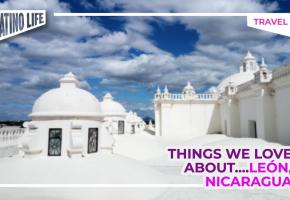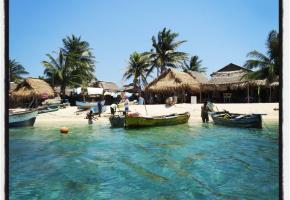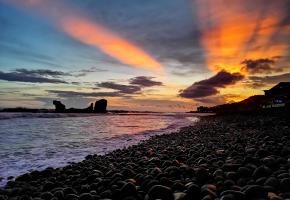Greeted by a strong whiff of sulphur that comes and goes with the wind, I take my last few steps up a steep stony path to the lip of the jagged crater and stare down at the bubbling green waters in the caldera below. It's a hell of a way to get over jet lag, but on my first morning in El Salvador I've managed a 40 minute trek up to the summit of Santa Ana, an active stratovolcano that last exploded into action in 2005. At 2,381 metres above sea level Santa Ana is the highest of El Salvador's 23 volcanoes and the panorama on this bright sunny day is stunning. To my right are the forested slopes of Cerro Verde volcano, and the black cinder cone of Izalco, a youngster at only 250 years old. To my left is the huge crater lake of Coatepeque, a bowl of shimmering turquoise water 5 km in diameter that was formed at least 56,000 years ago.
Known as El Pulgarcito de América (the Tom Thumb of the Americas), tiny El Salvador is the smallest and most densely populated country in Central America but from up here it looks vast and empty. What's more amazing is that we are only an hour from the capital San Salvador.
"It's beautiful, no?", says my guide Carlos Belloso, still puffing from the climb. "You see how blessed we are in El Salvador".
Carlos explains that the French aviator and author Antoine de Saint Exupery came here with his Salvadorian wife Consuelo Suncín and this spectacular landscape of volcanoe inspired him to write his famous book The Little Prince.
"The thorny rose of the story is Consuelo", says Carlos. "The three volcanoes on the planet that the little prince visits are these".
On the way down from the volcano we stop at a fruit stall selling bunches of Flor de Izote, the blossoms of the yucca palm and the national flower of El Salvador. It's also a prized culinary ingredient in several traditional dishes and the only national flower I can think of that you eat.
Don Ramon and his daughter Mariela offer us a taste of the fleshy petals which have a nutty slightly bitter taste.
"Izote is good with scrambled eggs", says Mariela, as Don Ramon slices a zapote fruit with his machete for us to try.
Down at Coatepeque we pull up at a restaurant on stilts over the lake. Local families are busy tucking into huge surf and turf platters as a trio of stetson-wearing guitarists go from table to table singing nostalgic boleros. A dive into the cool waters of the lake from a wooden platform washes away the dust from the morning's walk, the healing volcanic properties of the water living up to their reputation. As I swim around admiring the view the trio plays "Triste Camino", a 1940s classic from the Trio Vegabajeño.
Back in the restaurant we order big bottles of the local lager Regia Extra. Served ice cold, the beer tastes like heaven, and at $2 a go is a bargain. The meals are reasonable too, coming in at $8 a head. It certainly helps when totting up the bill that the national currency is the dollar.
"When something is really cool we say it is 'chivo'", says Carlos.
Well, El Salvador is really chivo, I tell him, ordering another Regia.
It was only the first day of our visit, but already El Salvador had proved to be a revelation. It is nothing like the one dimensional picture the media portrays but is full of natural treasures, outdoor adventures, welcoming locals, and great food.

Coffee hills and Strange Flavours
The next couple of days took us on the Ruta de Las Flores, a scenic route through the coffee hills west of San Salvador that passes through Nahuizalco, Salcoatitán, Juayua, Apaneca, and Ataco - five pretty rural towns with cobblestone streets, white-washed churches, and bright murals depicting village life. In Nahuizalco, it was like a mural had come to life as indigenous women in colourful blouses balanced large baskets filled with bright red jocote fruit on their heads and mums with babies in tow tended market stalls piled high with beans and corn and every variety of squash.
Just outside Ataco, we visit the El Carmen Estate, a coffee processing plant founded in 1930 where you can try some of the best premium coffee in El Salvador and tour the installations. Starting with the washing, pulping, husking, and drying of the beans, the tour takes you through the factory where huge belt driven machines like something out of Willy Wonka shake, spin and wrestle the poor beans into submission before conveying them into the roasting shed where all the magic takes place. Top gourmet varietals such as bourbon, catimorra and geisha are shipped from here to Amsterdam and Tokyo, and to big buyers like Starbucks and Illy.
As coffee tours go, $6 to learn the whole process of coffee production from bean to cup was money well spent, and the aromatic pacamara beans in my final tasting cup gave me a new appreciation of good gourmet coffee.
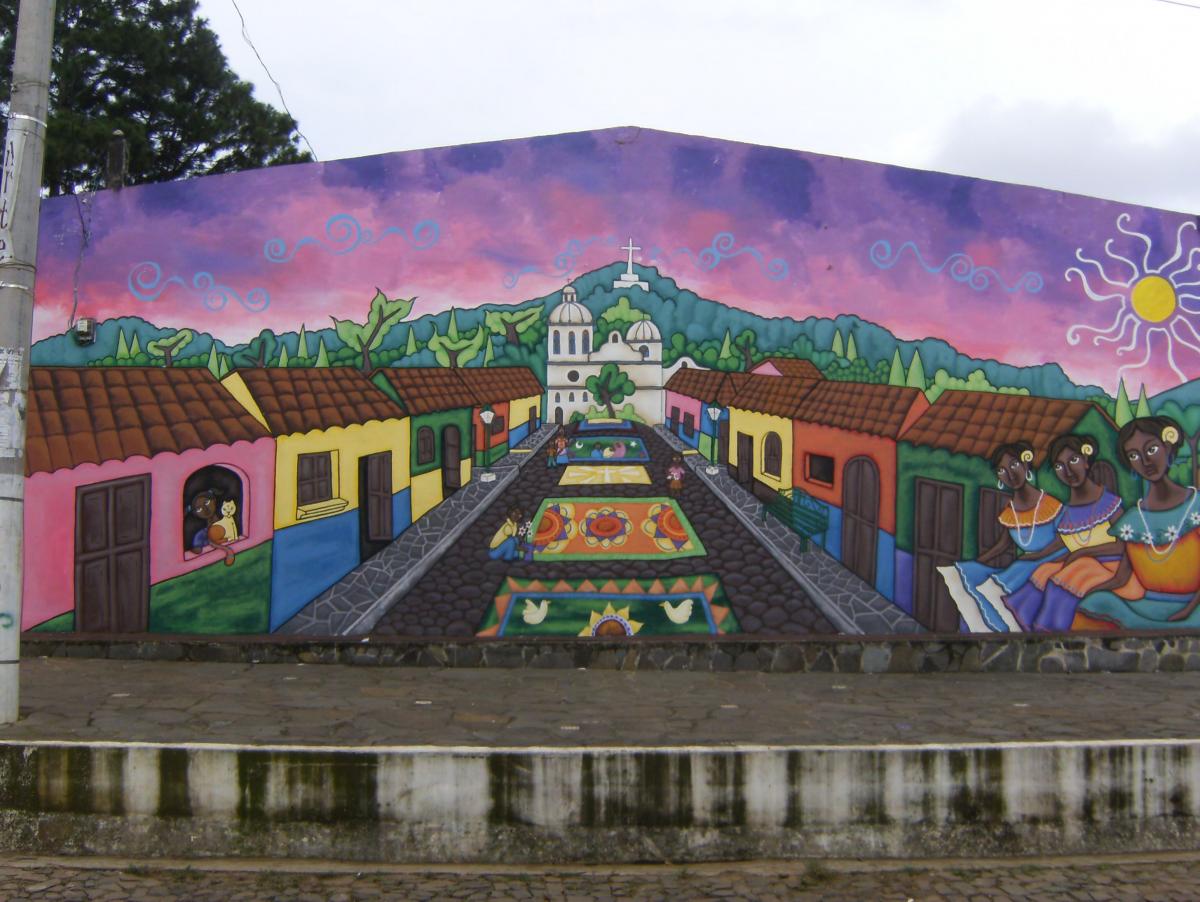
Santa Ana, Shuco and Pupusas
Arriving at dusk in Santa Ana, El Salvador's second largest town, we zip pass the ornate neo-Gothic cathedral with its spiky spires, and the famously ornate facade of the Teatro Nacional and head straight to Parque Libertad, the central square, to try a local delicacy.
The word shuco, or chuco, means 'fermented' in Nahuatl, the language of the Aztecs, a hint of its ancient indigenous roots. A type of atol (maize meal drink), shuco is made from a fermented mash of maíz morado (purple corn) that is boiled up into a thick purple soup and served hot with a spoonful of black beans, a dash of red chile sauce, and a generous sprinkle of a green powder made of toasted squash seeds called alguashte - al-wash tay.
The taste is unique, to say the least.
"It sells best in the early hours", says Doña Liset, explaining that local drinkers like to finish a session on the booze with a cup of shuco to soak up the alcohol.
"Es para cuando uno anda de goma", says a man hanging out at Liset's shuco cart: "It's for when you've got a hangover".
Later, at La Pradera restaurant, I get a chance to make my own dinner when Juanita the cook agrees to let me into the kitchen for a masterclass in making pupusas, the national dish of El Salvador. These delicious stuffed tortillas are a breakfast lunch and dinner staple and surprisingly easy to prepare. Taking a ball of maize dough I poke a paste of refried beans, cheese, and pork rinds into the centre, and then closed it over and pat it into a disc before slapping it on the griddle. My first revuelta - as this tasty combo is known – is a bit wonky, but by pupusa number three I am picturing myself opening a food stall back in London.
With vegetarian combinations of squash, jalapeño, and loroco flowers to stuff them with, pupusas really are the perfect snack. Served with a zingy vinegar slaw and fresh tomato sauce they sell on the street for 50 cents to $1 each.
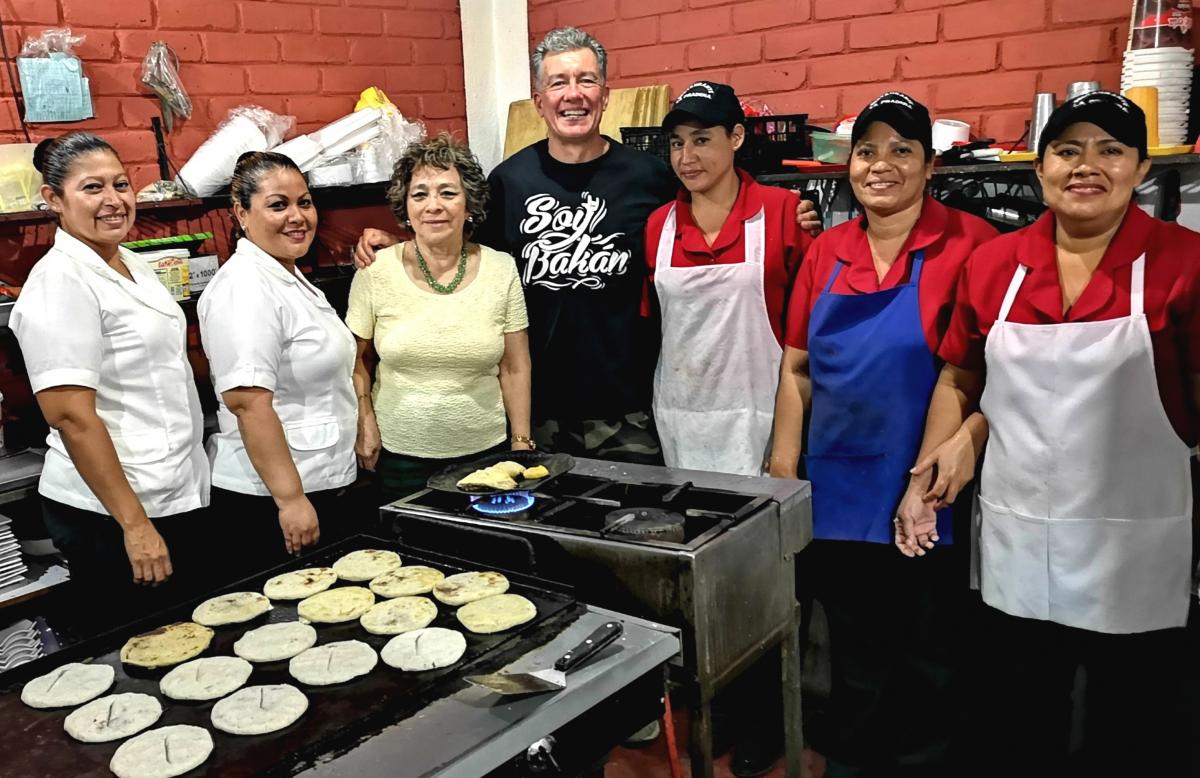
Moonshine and Chicken Soup
A pocket whirlwind, Claudia Caceres is on a one-woman crusade to rescue El Salvador's traditional country moonshine known as chaparro. At the Sacadera Flor de Fuego distillery in Guazapa, just 45 minutes from the capital she shows us the big copper still that produces her Flor de Fuego spirit from a fermented mash of panela (raw sugar) and corn.
"Chaparro is the true taste of El Salvador, our heritage, our culture. Like tequila in Mexico or cachaca in Brazil" she says with passion, handing out glasses of the fiery clear liquid that is coming out of the still at about 50 degrees proof. It's about 10 in the morning but it would be rude to say no to a shot. Unexpectedly sweet, with a slight fruitiness and none of the roughness you normally associate with moonshine, Flor de Fuego goes down remarkably easy.
Thanks to Claudia's efforts chaparro now has it's very own DO (Denominacion de Origen), just like champagne or Cornish pasties. Claudia is also working on a range of naturally-flavoured chaparro liqueurs made with local fruits such as tamarindo and nance. We say goodbye reluctantly, Claudia is a great host and her zeal for Flor de Fuego and determination to promote all that's best about El Salvador is infectious.
The gastronomic adventures continue in Suchitoto, a colonial treasure of cobblestoned streets, shady plazas, and pastel-painted houses. From the deck of Casa 1800, a boutique hotel and cafe with an amazing view over the huge man-made lake of Suchitlan I tuck into the signature dish, Gallina de Rosita soup, a delicious journey into the culinary traditions of El Salvador that comes with an unusual garnish, a whole chicken's foot.
The dish comes with a gourd cup of horchata, a refreshing drink made from jicaro seeds, rice, cinammon and spices, but I couldn't miss the opportunity to try a local craft beer, a crisp artisan lager from the Sivar Brewing Company.
Lunch followed a hike down to the rare rock formations of Los Tercios, a 10m waterfall that cascades down thick hexagonal columns of volcanic rock that rise vertically from the base, like a mini version of the Giant's Causeway in Ireland. The waterfall was dry but it was fascinating to clamber over the rocks and examine the strange columns.
As a courtesy, the local Suchitoto police accompany us down to the base of the falls - for safety reasons rather than security, they stress. As we stand with them at a viewpoint near the falls they point out a group of misty hills that mark the border with Honduras, my next destination.
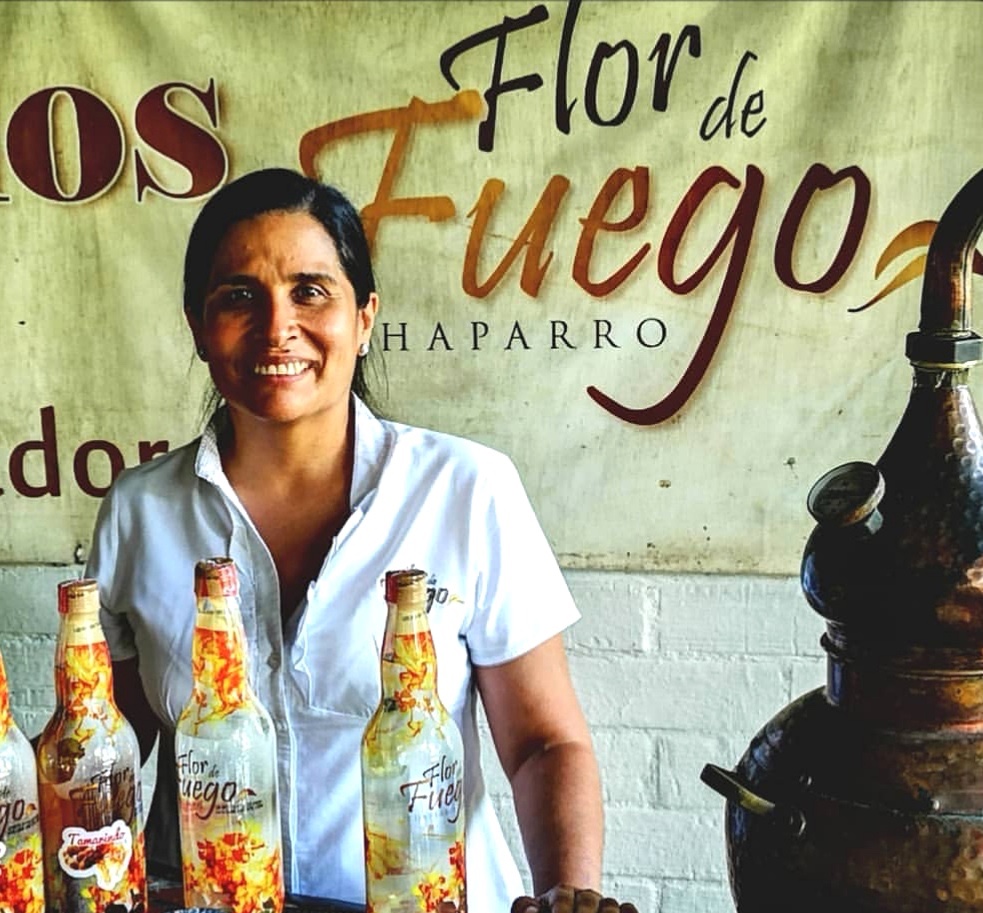
Snorkeling the Mesoamerican Reef
You don't immediately think of a laid back Caribbean paradise when you think of Honduras, but travel to Roatán in the Bay Islands and that's exactly what you get, a 50km-long strip of forested hills fringed by golden sands, dense mangroves, and thriving corals that is only 4-km wide.
Arriving on a surprisingly short 40-minute flight from San Salvador I'm struck by how easy it is to country-hop around Central America, and how distinct the different countries of the region can be, especially this switch from Pacific coast to Caribbean island.
At a roadside bar I try an ice-cold Salvavida lager served to a soundtrack of roots reggae and happy chatter in drawling English Creole.
"You know why people speak English here, papi", says Yivanny Fiallos, my cheery guide. "Your pirates of the Caribbean came here, Henry Morgan and the rest. But we don't mind, papi. In Roatán it's all about the good times".
The plan is to relax into the island's reggae vibe, and take a few days exploring the teeming undersea world of the MesoAmerican Barrier Reef, the second largest coral reef on the planet.
Roatán and the other Bay Islands, Utila and Guanaja, attract divers from all over, especially Utila, famed as one of the cheapest places to do a diving course in the world, but I'm happy just to snorkel.

At West Bay, the best beach on the island, you don't even need a snorkel and mask to find Dory. Right in front of the Grand Roatan Caribbean Resort the sea is so clear and the tropical fish so friendly I just had to wade out a few metres to see a shimmering show of flashing blues and bright yellows under the water.
Later, led by a guide, the full majesty of the reef became apparent. I have never seen so much sealife and such healthy coral so close to a popular beach in the Caribbean. For 40 minutes we snorkeled in wonder past sea fans and brain corals, through schools of bright blue dories, to a ledge that dropped at least 15 metres down into the dark blue depths. As we turned back for the beach, the emerald green head of a large moray eel poked out of a crack in the coral and fixed me with its beady grey eyes but I was too absorbed to worry, pleased to have had this Blue Planet moment.
I was only four days into my Central American adventure and already all the usual stereotypes about El Salvador and Honduras had been blown away by the warmth of the people, the magnificence of the geography, and the ease of travel.
As I washed away the salty taste of the sea with an ice-cold Salvavida lager, tucked into a crispy red snapper served with rice and fried plantains, and enjoyed another spectacular Central American sunset I could only smile at the thought of the further adventures that awaited me on the rest of my trip through Honduras.
Next week...Part 2 - Conch Soup, Castaway Islands, and Canyoning Down the Rio Cangrejal
Russell Maddicks is the author of Culture Smart! Guides to Cuba, Ecuador, Mexico, and Nicaragua and is currently working on the Bradt Guide to Colombia. Follow him on Twitter and Instagram @LatAmTravelist.



